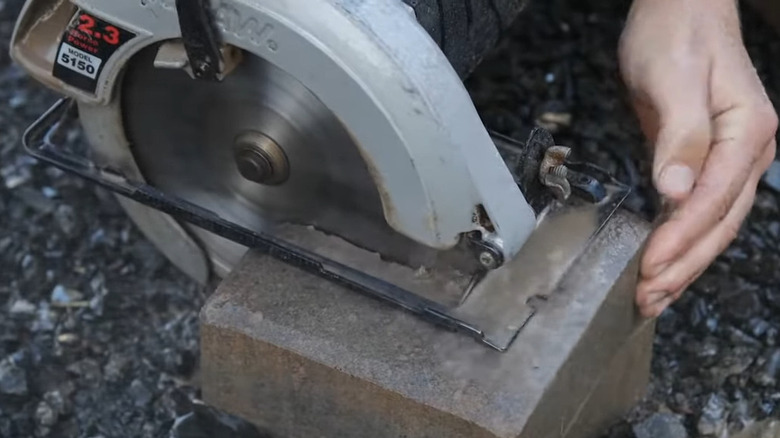How To Cut Paver Stones For The Perfect Fit In Your DIY Home Project
Paving stones (or pavers) can be used in a wide range of DIYs. Of course, they're fabulous for adding curb appeal to your yard, but they can also be transformed into everything from a low-cost side table to a modern planter. No matter the project, though, you'll likely need to cut at least some of the stones to size. This may sound daunting, given that pavers are most often made of brick, stone, or concrete, but with the right tips, anyone can master this advanced DIY.
The simplest way to proceed is with a hammer and chisel. First, mark where you plan to cut using a ruler and permanent marker, carpenter pencil, or chalk. Do this on the top, bottom, and sides of the paver, put on your protective glasses, then chisel along the marked lines a few times to "score" them. Once you have a groove that's about ¹⁄₁₆ inch deep, place the chisel in the middle of the stone and hammer it hard to split the stone in half. This option is great if you want to cheaply cut a few stones and you're not fussed about a perfect finish, although the chisel can somewhat even out rough edges.
A paver splitter, which looks and functions like a guillotine, is equally easy to use and is better suited for projects requiring a larger number of cut pavers. It can be rented for as little as $16, but the cuts still won't be smooth. For more professional results, read on.
Cutting pavers like a pro
If your project requires cutting a large number of stones with greater precision, consider one of several power tools (all of which can be rented from your local hardware store). Just remember to put on a dust mask and hearing protection first.
If your pavers are made of concrete, use a concrete saw; otherwise, opt for a circular saw with a diamond blade. After marking your stones, hold a paver steady on a flat surface or other paver, and run across the marked line all the way through, splitting it in half. Alternatively, cut a ridge that's ½- to 1-inch deep on the top and button, then use a hammer and mallet to tap along the cut and break the paver along the line. Either way, be sure to work next to a hose that will keep your stones wet throughout the cutting. Not only will this prevent you from breathing in harmful silica dust, but cutting dry concrete is actually illegal in several states.
For even more professional-grade results, you can also rent a wet tile saw. This machine is bulkier but is actually easier (and safer) to use than the handheld options above. It features both a table and guide, so you can get the perfect smooth cut on your first try. Finally, if your DIY requires a huge amount of cut stones, you can consider a masonry saw, but this option is mostly reserved for commercial settings.

